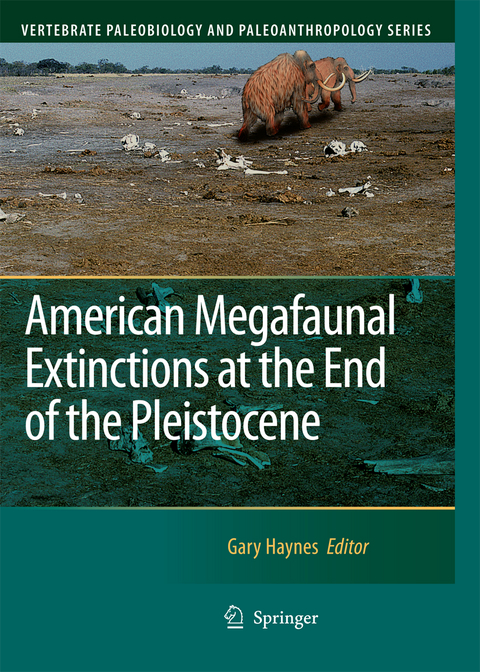
American Megafaunal Extinctions at the End of the Pleistocene
Springer (Verlag)
978-90-481-7989-3 (ISBN)
The volume contains summaries of facts, theories, and unsolved problems pertaining to the unexplained extinction of dozens of genera of mostly large terrestrial mammals, which occurred ca. 13,000 calendar years ago in North America and about 1,000 years later in South America. Another equally mysterious wave of extinctions affected large Caribbean islands around 5,000 years ago. The coupling of these extinctions with the earliest appearance of human beings has led to the suggestion that foraging humans are to blame, although major climatic shifts were also taking place in the Americas during some of the extinctions. The last published volume with similar (but not identical) themes -- Extinctions in Near Time -- appeared in 1999; since then a great deal of innovative, exciting new research has been done but has not yet been compiled and summarized. Different chapters in this volume provide in-depth resumés of the chronology of the extinctions in North and South America, the possible insights into animal ecology provided by studies of stable isotopes and anatomical/physiological characteristics such as growth increments in mammoth and mastodont tusks, the clues from taphonomic research about large-mammal biology, the applications of dating methods to the extinctions debate, and archeological controversies concerning human hunting of large mammals.
Gary Haynes, archeologist and author of two related books, Mammoths, Mastodonts, and Elephants (Cambridge University Press, 1993) and The Early Settlement of North America: The Clovis Era (Cambridge University Press, 2002). He has spent nearly 30 years working in actualistic studies of large-mammal bones in Africa, Australia, and North America, and has also been deeply involved in Paleoindian research for even longer.
to the Volume.- Sudden Deaths: The Chronology of Terminal Pleistocene Megafaunal Extinction.- Estimates of Clovis-Era Megafaunal Populations and Their Extinction Risks.- Paleobiology and Extinction of Proboscideans in the Great Lakes Region of North America.- Human Prey Choice in the Late Pleistocene and Its Relation to Megafaunal Extinctions.- Ancient DNA and the Genetic Consequences of Late Pleistocene Extinctions.- Did Humans Cause the Late Pleistocene-Early Holocene Mammalian Extinctions in South America in a Context of Shrinking Open Areas?.- The Elusive Evidence: The Archeological Record of the South American Extinct Megafauna.- Insulae infortunatae: Establishing a Chronology for Late Quaternary Mammal Extinctions in the West Indies.- Afterword, and Thoughts About the Future Literature.
From the reviews:"This excellent volume is an antidote to the rhetorical bombast. Haynes … thoroughly, fairly, and at times humorously frames the debate and puts the present studies in context. Eleven contributors present methodologically sound approaches that result in data-rich research. … Summing Up: Highly recommended. Academic and professional libraries, upper-division undergraduate and above." W. L. Cressler III, Choice, Vol. 46 (11), August, 2009." Provides a very valuable overview of the current state of the extinction literature, referencing not just publications but also numerous conference presentations. Provide the broadest (and, in many respects, the most helpful) perspective by considering North and South America in conjunction rather than in isolation. Jeffrey V. Yule, Evolutionary Anthropology 18:159-160, 2009.“Addresses one of the most controversial issues of the last glacial period, which affected ecosystems around the world: American megafaunal extinctions. … discusses the extinction of genera across North and South America, with a single chapter focusing on the West Indies. … the book appears smartly presented, a slim hardback book that is well laid out, with clear black-and-white images scattered throughout the chapters. … a book designed for hardcore specialists focusing on the minutiae of extinction events specifically in the Americas … .” (Alexander J. E. Pryor, Archaeological Review from Cambridge, Vol. 25 (1))
| Erscheint lt. Verlag | 30.11.2010 |
|---|---|
| Reihe/Serie | Vertebrate Paleobiology and Paleoanthropology |
| Zusatzinfo | VII, 201 p. |
| Verlagsort | Dordrecht |
| Sprache | englisch |
| Maße | 210 x 279 mm |
| Themenwelt | Geisteswissenschaften ► Archäologie |
| Naturwissenschaften ► Biologie ► Ökologie / Naturschutz | |
| Naturwissenschaften ► Geowissenschaften ► Geografie / Kartografie | |
| Naturwissenschaften ► Geowissenschaften ► Mineralogie / Paläontologie | |
| ISBN-10 | 90-481-7989-0 / 9048179890 |
| ISBN-13 | 978-90-481-7989-3 / 9789048179893 |
| Zustand | Neuware |
| Haben Sie eine Frage zum Produkt? |
aus dem Bereich


